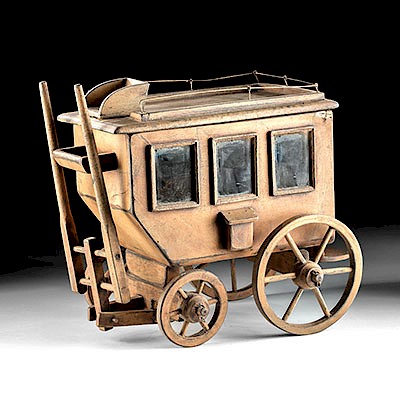Colombian Muisca 18K Gold Nude Tunjo Figure
Lot 56
About Seller
Artemis Gallery
686 S Taylor Ave, Ste 106
Louisville, CO 80027
United States
Selling antiquities, ancient and ethnographic art online since 1993, Artemis Gallery specializes in Classical Antiquities (Egyptian, Greek, Roman, Near Eastern), Asian, Pre-Columbian, African / Tribal / Oceanographic art. Our extensive inventory includes pottery, stone, metal, wood, glass and textil...Read more
Estimate:
$5,000 - $7,500
Absentee vs Live bid
Two ways to bid:
- Leave a max absentee bid and the platform will bid on your behalf up to your maximum bid during the live auction.
- Bid live during the auction and your bids will be submitted real-time to the auctioneer.
Bid Increments
| Price | Bid Increment |
|---|---|
| $0 | $25 |
| $300 | $50 |
| $1,000 | $100 |
| $2,000 | $250 |
| $5,000 | $500 |
| $10,000 | $1,000 |
| $20,000 | $2,500 |
| $50,000 | $5,000 |
| $100,000 | $10,000 |
| $200,000 | $20,000 |
About Auction
By Artemis Gallery
Nov 14, 2019
Set Reminder
2019-11-14 10:00:00
2019-11-14 10:00:00
America/New_York
Bidsquare
Bidsquare : Ethnographic | Tribal | American Frontier
https://www.bidsquare.com/auctions/artemis-gallery/ethnographic-tribal-american-frontier-4634
Featuring Pre-Columbian, Tribal / Oceanic, Spanish Colonial, historical examples from the Spanish, Mexican, and American frontiers, fossils, and more. All items offered for sale have been legally acquired, are legal to sell and are guaranteed to be as described or your money back. Artemis Gallery info@artemisgallery.com
Featuring Pre-Columbian, Tribal / Oceanic, Spanish Colonial, historical examples from the Spanish, Mexican, and American frontiers, fossils, and more. All items offered for sale have been legally acquired, are legal to sell and are guaranteed to be as described or your money back. Artemis Gallery info@artemisgallery.com
- Lot Description
Pre-Columbian, South America, Colombia, Muisca, ca. 1000 to 1550 CE. Expertly cast via the lost wax (cire perdue) process, a gold (75% gold, equivalent to 18K) stylized nude male figure presenting details of his face, limbs, hands, feet, genitals, and decorative ornaments either comprised of flat wirelike elements or cut out gold sheet. His expressive visage features coffee bean shaped eyes, a straight nose, and a coffee bean shaped mouth. Though nude, he is decorated with ear ornaments, a necklace, a shoulder ornament falling from the left shoulder, and an openwork crown or headband. His arms bend at the elbows so that his hands are held to his chest. Size: 6.75" H (17.1 cm); 7.125" H (18.1 cm) on included custom stand. Weight: 23.1 grams
This type of figure is known as a tunjo, meant as an offering to communicate with the gods. They are found deposited in Lake Guatavita and other important bodies of water in the region, buried in caches, as grave ornaments, and at the entrances to temples. The use of gold on this example indicates its value - most are made of copper or other less precious metals.
Julie Jones' "The Art of Precolumbian Gold" discusses Muisca gold tunjos as follows: "Human images are the most common type of Muisca tunjo, the class of metal objects found in the high Andes around Bogota, the present capital of Colombia, established by the Spaniards in 1539.The figures were used as votive objects; they were always differentiated by sex, and a great amount of specific detail was worked into them. Mothers and children, warriors, and coca chewers are common tunjo representations. Published information on the specific groupings of the objects as they were cached - the chief manner of offering - is scant. The Museo del Oro in Bogota has documented a good-sized group said to be the contents of a cache that was found shallowly buried in an open field in Funza, Cundinamarca . . ."
Jones continues with a discussion of Muisca goldsmithing techniques and practices, "Muisca tunjos were not worked after casting. Flaws were not corrected, excess metal was not removed, surfaces were not polished; they were left as they came out of the mold. Even molding sprues could remain. . . The spontaneity of manufacture plus the artistic means . . . and the manner in which they were used, set the Muisca tunjos apart from other Precolumbian gold objects." (Ed. Julie Jones, "The Art of Precolumbian Gold: The Jan Mitchell Collection." Boston: Little Brown and Company, 1985, p. 166)
Provenance: private Tennessee, USA collection
All items legal to buy/sell under U.S. Statute covering cultural patrimony Code 2600, CHAPTER 14, and are guaranteed to be as described or your money back.
A Certificate of Authenticity will accompany all winning bids.
We ship worldwide and handle all shipping in-house for your convenience.
#145878Minute casting flaws and sprues as is consistent with Muisca techniques. See discussion of these in extended description. Missing elements of right earring and possibly headdress and left shoulder ornament. Still marvelous with most elements very well preserved as well as quite sizeable.Condition
- Shipping Info
-
All shipping is handled in-house for your convenience. Your invoice from Artemis Gallery will include shipping calculation instructions. If in doubt, please inquire BEFORE bidding for estimated shipping costs for individual items.
-
- Buyer's Premium



 EUR
EUR CAD
CAD AUD
AUD GBP
GBP MXN
MXN HKD
HKD CNY
CNY MYR
MYR SEK
SEK SGD
SGD CHF
CHF THB
THB














